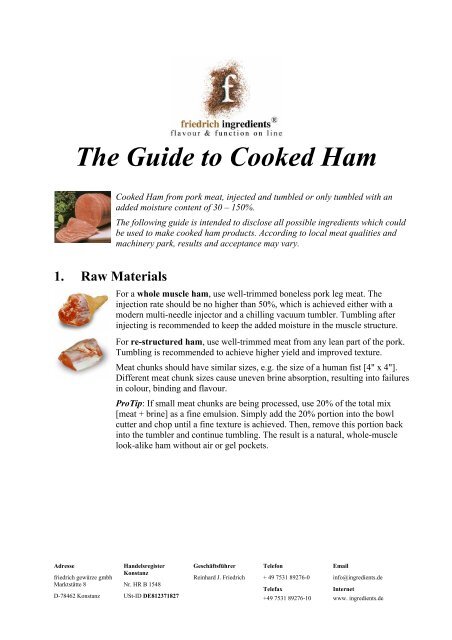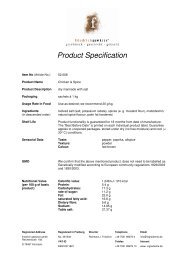The Guide to Cooked Ham - Friedrich Ingredients
The Guide to Cooked Ham - Friedrich Ingredients
The Guide to Cooked Ham - Friedrich Ingredients
You also want an ePaper? Increase the reach of your titles
YUMPU automatically turns print PDFs into web optimized ePapers that Google loves.
<strong>The</strong> <strong>Guide</strong> <strong>to</strong> <strong>Cooked</strong> <strong>Ham</strong><br />
<strong>Cooked</strong> <strong>Ham</strong> from pork meat, injected and tumbled or only tumbled with an<br />
added moisture content of 30 – 150%.<br />
<strong>The</strong> following guide is intended <strong>to</strong> disclose all possible ingredients which could<br />
be used <strong>to</strong> make cooked ham products. According <strong>to</strong> local meat qualities and<br />
machinery park, results and acceptance may vary.<br />
1. Raw Materials<br />
For a whole muscle ham, use well-trimmed boneless pork leg meat. <strong>The</strong><br />
injection rate should be no higher than 50%, which is achieved either with a<br />
modern multi-needle injec<strong>to</strong>r and a chilling vacuum tumbler. Tumbling after<br />
injecting is recommended <strong>to</strong> keep the added moisture in the muscle structure.<br />
For re-structured ham, use well-trimmed meat from any lean part of the pork.<br />
Tumbling is recommended <strong>to</strong> achieve higher yield and improved texture.<br />
Meat chunks should have similar sizes, e.g. the size of a human fist [4" x 4"].<br />
Different meat chunk sizes cause uneven brine absorption, resulting in<strong>to</strong> failures<br />
in colour, binding and flavour.<br />
ProTip: If small meat chunks are being processed, use 20% of the <strong>to</strong>tal mix<br />
[meat + brine] as a fine emulsion. Simply add the 20% portion in<strong>to</strong> the bowl<br />
cutter and chop until a fine texture is achieved. <strong>The</strong>n, remove this portion back<br />
in<strong>to</strong> the tumbler and continue tumbling. <strong>The</strong> result is a natural, whole-muscle<br />
look-alike ham without air or gel pockets.<br />
Adresse<br />
friedrich gewürze gmbh<br />
Marktstätte 8<br />
D-78462 Konstanz<br />
Handelsregister<br />
Konstanz<br />
Nr. HR B 1548<br />
USt-ID DE812371827<br />
Geschäftsführer<br />
Reinhard J. <strong>Friedrich</strong><br />
Telefon<br />
+ 49 7531 89276-0<br />
Telefax<br />
+49 7531 89276-10<br />
Email<br />
info@ingredients.de<br />
Internet<br />
www. ingredients.de
2. Seasoning and <strong>Ingredients</strong> Per kg Saleable <strong>Ham</strong> Product<br />
<strong>Cooked</strong> <strong>Ham</strong><br />
F+F Pro<br />
StarchMaxx<br />
tapioca starch<br />
Smokin’ Joe<br />
only<br />
3%<br />
<strong>to</strong><br />
the<br />
brine<br />
1<br />
-<br />
5%<br />
2<br />
-<br />
2½%<br />
1<br />
–<br />
3%<br />
0.1<br />
–<br />
0.2<br />
%<br />
0.2<br />
–<br />
0.5<br />
%<br />
<strong>Cooked</strong> <strong>Ham</strong> F+F Pro, the complete carrageenan based Flavour +<br />
Function System for <strong>Cooked</strong> <strong>Ham</strong>s of 30% yield or higher. Only one<br />
product for all yields. Best cost : performance – ratio due <strong>to</strong> low usage<br />
rate.<br />
Check Online Brine Calcula<strong>to</strong>r for complete, tailor-made brine<br />
manufacturing recipe. Always pre-blend <strong>Cooked</strong> <strong>Ham</strong> F+F Pro with the<br />
same amount of salt before dissolving in the brine for best distribution<br />
results.<br />
Starch – pota<strong>to</strong>, corn or tapioca starch. We recommend <strong>to</strong> use flavourneutral<br />
StarchMaxx, a native tapioca starch, food grade. Use in ham<br />
pickling brines <strong>to</strong> bind excess moisture, and in the tumbler <strong>to</strong> bind excess<br />
moisture which was not absorbed during the tumbling period.<br />
ProTip: For best results, add the starch after 1/3 of the <strong>to</strong>tal tumbler time<br />
[example: after 3 of 9 hours <strong>to</strong>tal]. Starch should only bind the excess<br />
water which is neither absorbed by the meat nor the carrageenan.<br />
Nitrite Curing Salt. If no ready-<strong>to</strong>-use curing salt is not available, we<br />
recommend <strong>to</strong> use CureMix5/5. Cure Mix 5/5 contains 5% sodium<br />
nitrite and 5% potassium nitrite.<br />
Mix 1 part Cure Mix 5/5 with 9 parts of regular salt <strong>to</strong> achieve a curing<br />
salt with 1% active cure content.<br />
Dextrose. Use <strong>to</strong> cover unwanted salt-flavour when higher salt addition<br />
is needed <strong>to</strong> preserve freshness and yield.<br />
Improves mouthfeel and texture. Reduces the a w -value which results in<strong>to</strong><br />
reduced micro-biological activities.<br />
Optional: Smokin’ Joe smoke flavour in powder form, on carrier salt.<br />
Adds old-fashioned smoke flavour <strong>to</strong> ham products without the need of<br />
actually smoking the product after cooking.<br />
Save time and energy, and reduce pollution by using Smokin’ Joe<br />
instead of naturally burnt smoke.<br />
Optional: Garlic Extra, highly concentrated liquid garlic extract, made<br />
from fresh garlic cloves. Use <strong>to</strong> round off flavour or cover undesired offflavours.<br />
Long-lasting flavour retention. Garlic has anti-bacterial<br />
properties.<br />
Clean label declaration [spice or garlic].<br />
Check our website for more information, including<br />
ingredient declaration and prices: http://www.ingredients.de<br />
page 2 of 3 recipe cooked ham dated 13.11.2004
3. Processing Information<br />
Pho<strong>to</strong> courtesy of<br />
Maja Machines:<br />
http://www.maja.de<br />
Pho<strong>to</strong>s courtesy of<br />
Günther Machines:<br />
http://www.guenthermaschinenbau.de<br />
Pho<strong>to</strong> courtesy of<br />
Fessmann<br />
Smokehouses:<br />
http://www.fessmann.de<br />
1<br />
Meat Preparation<br />
Especially for whole muscle ham, it is highly recommended that the meat<br />
chunks are separated from the membrane by using a skinner. This will improve<br />
binding considerably due <strong>to</strong> higher protein release of the meat.<br />
Skinning machines are available in butcher shop sizes up <strong>to</strong> fully au<strong>to</strong>matic<br />
membrane skinning machines, for pork, beef, lamb, game and poultry<br />
applications.<br />
Brine Preparation<br />
Prepare a pre-mix of <strong>Cooked</strong> <strong>Ham</strong> F+F and the same or larger quantity of salt<br />
& cure/curing salt. Dissolve this pre-mix first. Add all other dry ingredients,<br />
followed by the liquid ingredients, and finally the remaining salt. Use partly ice<br />
flakes instead of water, if necessary, <strong>to</strong> keep the brine temperature below 2° C<br />
for best shelf-life results.<br />
Continuous stirring is preferred <strong>to</strong> keep all ingredients well dispersed at all times<br />
Injecting<br />
Depending on the equipment used, the needed amount of brine can be injected in<br />
one or more strokes. <strong>The</strong> remaining brine is added in<strong>to</strong> the tumbler, <strong>to</strong>gether<br />
with the injected meat. 1.8 bar pressure is recommended.<br />
ProTip: Multiple injecting using low pressure is preferred over single, high<br />
pressure injecting. High pressure injecting may cause damage of the meat’s<br />
structure, causing gel pockets and uneven brine distribution.<br />
Tumbling<br />
Most modern tumblers offer vacuum tumbling in intervals. We recommend <strong>to</strong><br />
use 30 minutes tumbling, followed by 15 minutes rest, which translates in<strong>to</strong> 40<br />
minutes tumbling time per hour. 80% vacuum is recommended.<br />
A <strong>to</strong>tal tumbling time of 15 h [10 h <strong>to</strong>tal tumbling + 5 h <strong>to</strong>tal rest time] should<br />
absorb all the brine. Any excess brine may be absorbed with StarchMaxx.<br />
Cooking, Chilling<br />
Carrageenan needs a temperature of 70° C <strong>to</strong> form a non-reversible network with<br />
the meat’s very own protein, yet resulting in<strong>to</strong> increased water binding and<br />
holding performance. Usually, 72° C internal cooking temperature is used <strong>to</strong><br />
reach maximum product shelf life.<br />
After the desired internal temperature is reached, immediately chilling is<br />
essential <strong>to</strong> s<strong>to</strong>p the cooking process, avoiding further loss of juices.<br />
S<strong>to</strong>re at 2 – 4 ° C for at least 24 h before slicing or shipping<br />
1 This recipe was developed with the best of knowledge, and according <strong>to</strong> <strong>to</strong>day’s technical standards. However,<br />
we cannot accept any responsibility for the result or lack of acceptance.<br />
page 3 of 3 recipe cooked ham dated 13.11.2004
















